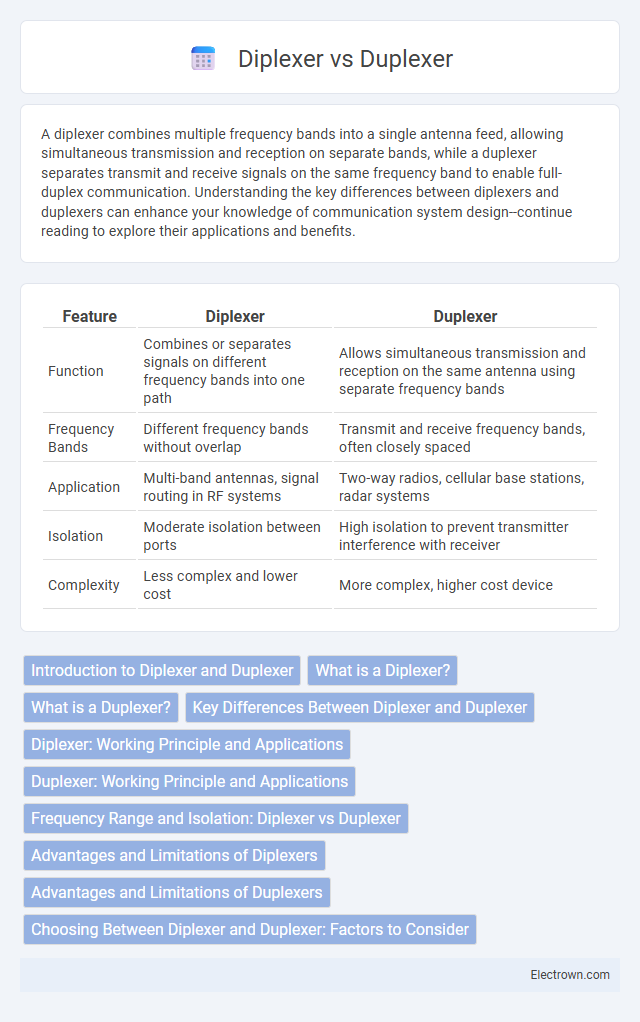A diplexer combines multiple frequency bands into a single antenna feed, allowing simultaneous transmission and reception on separate bands, while a duplexer separates transmit and receive signals on the same frequency band to enable full-duplex communication. Understanding the key differences between diplexers and duplexers can enhance your knowledge of communication system design--continue reading to explore their applications and benefits.
Table of Comparison
| Feature | Diplexer | Duplexer |
|---|---|---|
| Function | Combines or separates signals on different frequency bands into one path | Allows simultaneous transmission and reception on the same antenna using separate frequency bands |
| Frequency Bands | Different frequency bands without overlap | Transmit and receive frequency bands, often closely spaced |
| Application | Multi-band antennas, signal routing in RF systems | Two-way radios, cellular base stations, radar systems |
| Isolation | Moderate isolation between ports | High isolation to prevent transmitter interference with receiver |
| Complexity | Less complex and lower cost | More complex, higher cost device |
Introduction to Diplexer and Duplexer
Diplexers and duplexers are essential RF components used to manage multiple signals over a single antenna system. A diplexer separates or combines signals operating on different frequency bands, enabling simultaneous transmission and reception without interference. Your communication system benefits from a duplexer by allowing bidirectional communication on the same frequency band, efficiently isolating the transmitter and receiver paths.
What is a Diplexer?
A diplexer is a passive radio frequency (RF) device that enables two signals at different frequency bands to share a common antenna without interference. It combines or separates signals based on frequency, allowing simultaneous transmission and reception using a single antenna system. Diplexers are widely used in communication systems to optimize spectrum efficiency and reduce hardware costs.
What is a Duplexer?
A duplexer is a device used in communication systems to allow a single antenna to transmit and receive signals simultaneously by separating the incoming and outgoing frequencies. Unlike a diplexer, which splits or combines signals across different frequency bands without simultaneous transmission, a duplexer enables full-duplex communication by isolating transmitter and receiver paths. Your network performance improves by using a duplexer to minimize interference and maximize spectral efficiency in wireless applications.
Key Differences Between Diplexer and Duplexer
Diplexers separate or combine signals from different frequency bands, enabling a single antenna to handle multiple frequencies simultaneously, often used in communication systems to share one antenna for transmission and reception. Duplexers allow simultaneous transmission and reception of signals on the same frequency band without interference, commonly used in two-way radios and radar systems to isolate transmit and receive paths. Understanding these key differences ensures you select the right device for efficient frequency management and improved system performance.
Diplexer: Working Principle and Applications
A diplexer functions by combining or separating signals based on different frequency bands, enabling multiple communication channels to share a common antenna without interference. Its working principle relies on passive filtering components that direct signals to the appropriate ports based on frequency, allowing simultaneous transmission and reception through a single antenna system. Your communication setup benefits from diplexers in applications like satellite communications, radio transmitters, and cellular base stations where efficient frequency management is crucial.
Duplexer: Working Principle and Applications
A duplexer operates by isolating a transmitter and receiver within a single antenna system, enabling simultaneous two-way communication without interference through frequency or time-division separation techniques. It uses filters such as diplexers or circulators to separate incoming and outgoing signals, critical in radar systems, two-way radios, and cellular base stations. Your choice of a duplexer enhances communication efficiency by allowing concurrent transmission and reception on shared hardware, optimizing spectrum use in wireless networks.
Frequency Range and Isolation: Diplexer vs Duplexer
Diplexers typically operate over broad frequency ranges, effectively separating signals into distinct bands with isolation levels around 30-40 dB, suitable for combining or splitting transmit and receive paths without interference. Duplexers focus on narrow frequency bands with much higher isolation, often exceeding 60 dB, enabling simultaneous transmission and reception on closely spaced frequencies in half-duplex or full-duplex radio systems. The choice between diplexer and duplexer depends on required frequency separation and isolation to minimize signal loss and prevent cross-talk in wireless communication setups.
Advantages and Limitations of Diplexers
Diplexers enable simultaneous transmission and reception of different frequency bands through a single antenna, optimizing spectrum efficiency and reducing hardware costs. Their main advantage lies in separating signals without interference, enhancing multi-band communication systems. However, diplexers have limitations such as potential insertion loss and less effective isolation compared to duplexers, which may affect signal quality in high-performance applications.
Advantages and Limitations of Duplexers
Duplexers offer the advantage of allowing simultaneous transmission and reception on a single antenna, enhancing communication efficiency and reducing hardware costs. However, their limitations include potential signal interference and the need for precise tuning to maintain isolation between transmit and receive paths. Your system's performance depends on carefully balancing these factors to optimize signal clarity and operational reliability.
Choosing Between Diplexer and Duplexer: Factors to Consider
Choosing between a diplexer and duplexer depends on your system's frequency requirements and isolation needs. A diplexer combines or splits signals in different frequency bands with moderate isolation, ideal for applications where transmit and receive frequencies are widely separated. Duplexers provide higher isolation and are suitable for simultaneous transmit and receive operations within closely spaced frequency bands, ensuring minimal interference in your communication system.
Diplexer vs Duplexer Infographic

 electrown.com
electrown.com